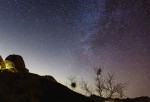UCLA researchers helped develop a new technique to improve the precision of the Hubble constant estimation, which is key in figuring out how quickly the universe is expanding.
The UCLA astronomers estimated the constant to be 72.5 kilometers per second per megaparsec in their study published Jan. 22. Previous estimates ranged from 67 to 73 kilometers per second per megaparsec.
The Hubble constant describes the rate at which the universe is expanding. According to UCLA Newsroom, methods for deriving the constant are usually based on the distance to a source of light and the light source’s redshift – the lengthening of light wavelengths that occurs when a light source moves further away from an observer.
The researchers used a new source of light in their research called quasars, which emit large amounts of light and energy and are thought to be powered by massive black holes.
The scientists studied double-image quasars, which have their light distorted by the gravity of a nearby galaxy, creating two images of the quasar.
A quasar’s brightness changes as it travels, so the images flicker after one another. The time delay between the flickers, as well as information about the surrounding galaxy’s gravitational field, helps researchers estimate the Earth’s distance to the quasar and the nearby galaxy.
Tommaso Treu, a professor of physics and astronomy and the paper’s senior author, said the researchers recorded the time-delay photos every day for several years and later combined their findings with previous data provided by the H0liCOW collaboration, an international group dedicated to measuring the expansion of the universe using time-delay cosmography.
Treu said the UCLA-led team is now focusing on 40 quadruply imaged quasars in hope of finding more precise data for their Hubble constant calculations rather than doubly imaged quasars.
